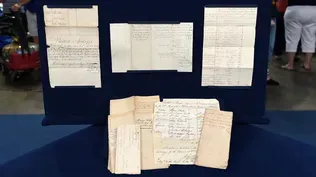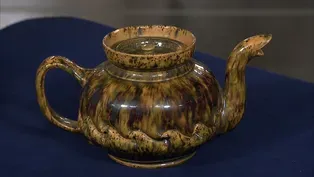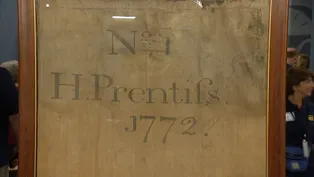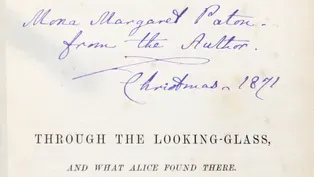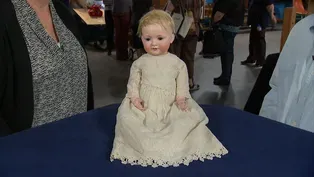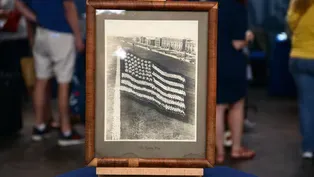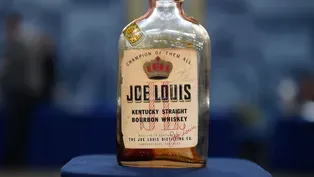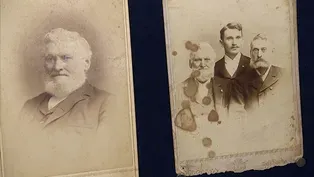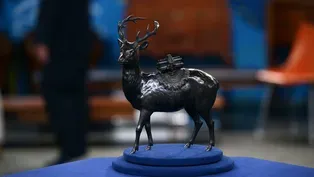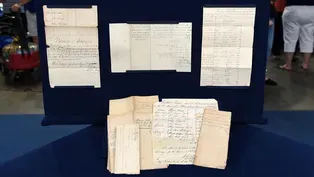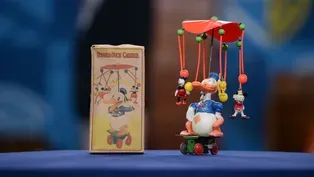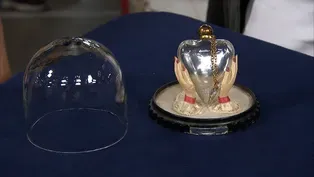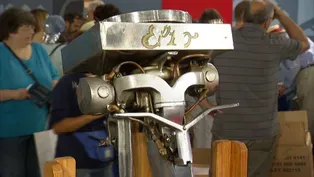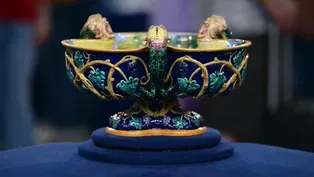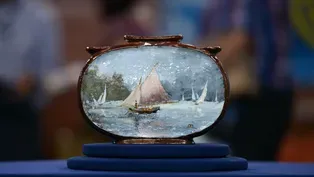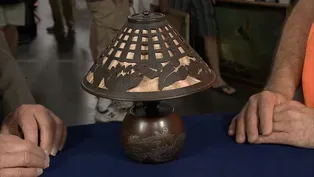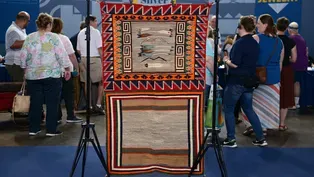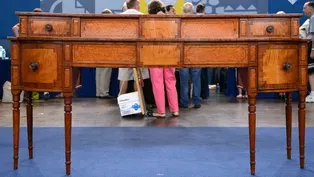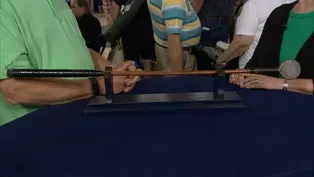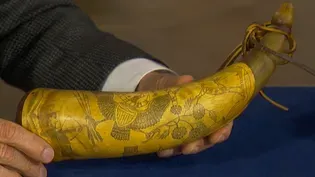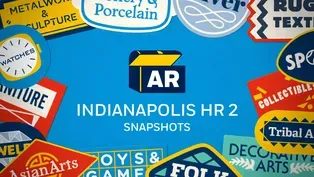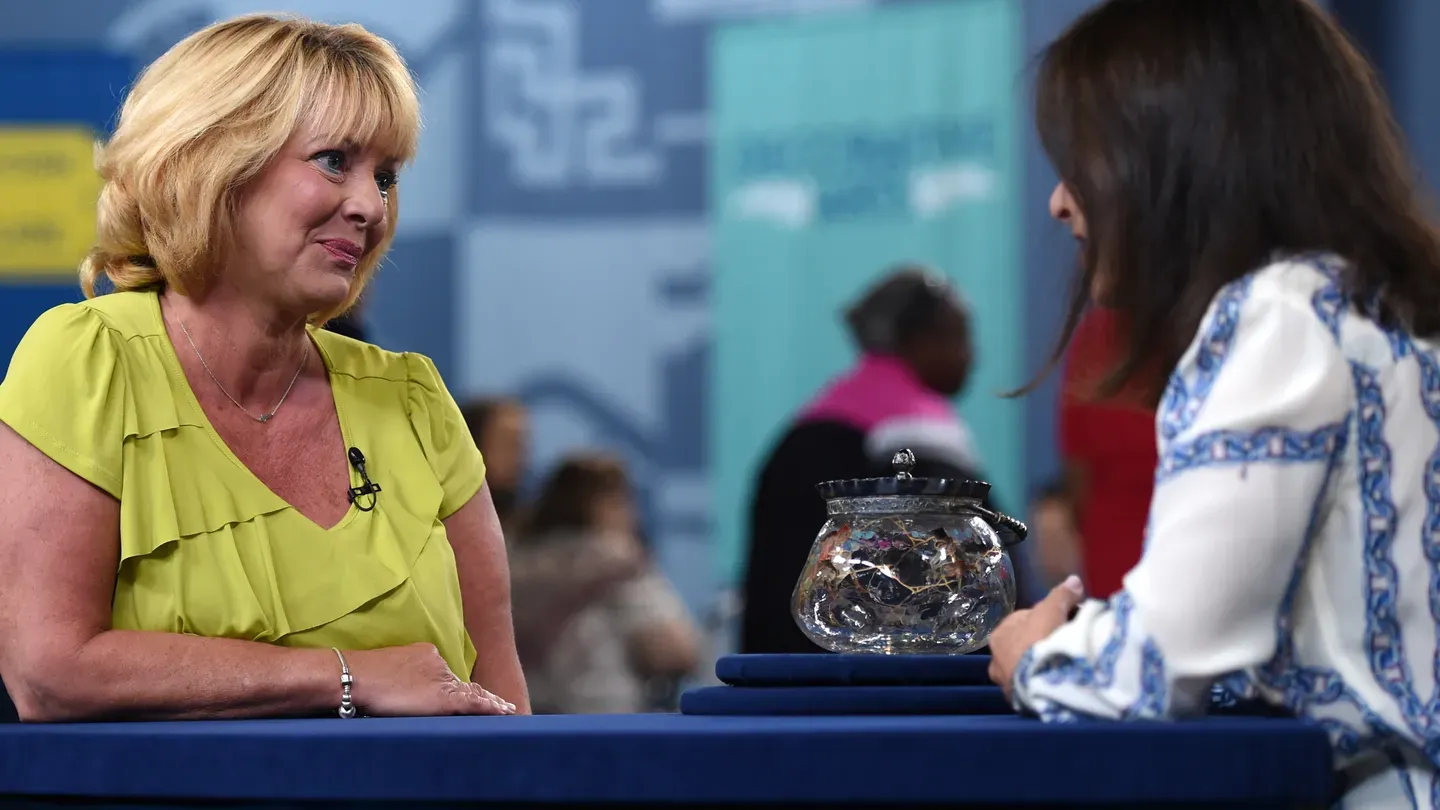

Indianapolis, Hour 2
Season 21 Episode 5 | 53m 1sVideo has Closed Captions
A Joe Louis-signed bottle, a Sheraton sideboard, and a Yankees team-signed ball.
Discover treasures from Indianapolis including a 1952 Joe Louis-signed whiskey bottle, a Sheraton sideboard, ca. 1820, and a 1928 NY Yankees team-signed baseball. Which one is the top find of the hour?
Problems with Closed Captions? Closed Captioning Feedback
Problems with Closed Captions? Closed Captioning Feedback
Funding for ANTIQUES ROADSHOW is provided by Ancestry and American Cruise Lines. Additional funding is provided by public television viewers.

Indianapolis, Hour 2
Season 21 Episode 5 | 53m 1sVideo has Closed Captions
Discover treasures from Indianapolis including a 1952 Joe Louis-signed whiskey bottle, a Sheraton sideboard, ca. 1820, and a 1928 NY Yankees team-signed baseball. Which one is the top find of the hour?
Problems with Closed Captions? Closed Captioning Feedback
How to Watch Antiques Roadshow
Antiques Roadshow is available to stream on pbs.org and the free PBS App, available on iPhone, Apple TV, Android TV, Android smartphones, Amazon Fire TV, Amazon Fire Tablet, Roku, Samsung Smart TV, and Vizio.

ANTIQUES ROADSHOW 2025 Tour!
Enter now for a chance to win free tickets to ANTIQUES ROADSHOW's 2025 Tour! Plus, see which cities we're headed to!Providing Support for PBS.org
Learn Moreabout PBS online sponsorshipWALBERG: Antiques Roadshow is finding treasure in Indianapolis, the capital city of the Hoosier State.
I brought in an autographed Joe Louis whiskey bottle.
You can only look at one side at a time.
That's right.
And this side is pretty good.
WALBERG: In Indianapolis, Antiques Roadshow took a stroll down Indiana Avenue to the Madame Walker Theatre Center.
This national historic landmark, erected in 1927, was the vision of cosmetics entrepreneur and self-made millionaire Madam C.J.
Walker.
Though she did not live to see its completion, the theater is a monument to her zealous support of African-American arts and culture, civic engagement, and to her legacy of pioneering business enterprise.
Back at the Roadshow, the business venture of a bold boxing champ was in the spotlight.
Take a look.
WOMAN: I brought in an autographed Joe Louis whiskey bottle.
My mother was a Joe Louis fan, and he was in Louisville, Kentucky, so she couldn't go because she had to stay home and babysit for us, so my father went to the nightclub because Joe Louis was promoting his whiskey, so he got her the autographed bottle.
So he had the whiskey and she got the bottle.
(both laughing) So what did your mom think when your dad... Oh, she was excited.
She would tell us stories about how, when she was younger, they didn't have a radio, so she listened to the first fight, or one of the few fights that Joe Louis had, on a radio at her neighbor's, on her neighbor's porch.
Oh, that's wonderful.
So she was excited.
She would have probably rather seen him in person, but at least she got his autograph.
Well, Joe Louis, one of the greatest heavyweight boxers of all time, he reigned as champion from 1937 to 1949, and had an outstanding, outstanding record.
Well, after he retired from professional boxing in 1949, he started small businesses, one of them being the Joe Louis whiskey.
It was a very short-lived product.
It was launched in 1952, and by late 1953, it was defunct, so this is an extraordinarily rare whiskey bottle on its own.
Oh, good.
Very short production run, very desirable, very collectible.
Wow.
And we've never seen one that was signed by Joe Louis.
And right here, you've got Joe Louis's signature, wonderful, right up above his own name, written in pencil.
What would your mom say if she knew you were here today, looking at this bottle and about to get it evaluated?
She would just be thrilled that I was on the Antiques Roadshow, because we used to watch it on a regular basis.
She'd be so excited.
(laughing) Well, we would put a conservative auction estimate for this bottle of Joe Louis whiskey at $1,200 to $1,500.
Wow, that's good!
Oh, excuse...
I'm excited, that's nice!
She'd be pleased.
For an empty bottle, yes.
Now, originally, this bottle would have come with two boxing gloves, and they're really neat, but they don't really add a whole lot of value to it.
If they had the original boxing gloves still attached, these short little guys, it would probably add another $100 in value to it.
Okay.
And even without the signature, it's still quite a valuable bottle, probably around $500 to $600 on its own.
Thank you.
WOMAN: This was given to me by a dear friend and neighbor of mine some years ago.
I don't really know a lot about it.
It looks almost English to me, but I noticed there's a mark on the bottom that says "Napoli," and that sounds Italian.
It does say "Napoli" on the bottom, and then there's a number underneath it.
This was made by a company called Mt.
Washington.
Okay.
And they made all different types of glass, Crown Milano and Royal Flemish.
But this particular glass was called Napoli.
Okay.
And it was interesting when I saw it, because I was a little confused, too.
But then I lifted the cover, and inside, there's an "MW" in there, which stands for Mt.
Washington.
They first opened in 1837 in South Boston, Massachusetts, and in 1870, they moved to New Bedford, Massachusetts.
So this piece was clearly made in New Bedford.
They actually merged with Pairpoint Glass in 1894, and Pairpoint would make some of the metalwork.
So this was an opportune moment for them to make a biscuit jar like this one.
Now, Napoli glass was made for a very short period of time, between 1894, when it was patented, and 1896.
Oh, my word.
And it was created by Albert Steffin, who was the head of Mt.
Washington.
Now, the little fanciful figures that you see, which I just think are so adorable, are based on Palmer Cox's Brownie figures.
Palmer Cox was a Canadian illustrator and author who wrote the Brownies series, and he illustrated...
In many of the books, you have these little figures of what he called Brownies.
Interesting.
In fact, it was so popular that one of the first hand-held cameras made by Eastman Kodak was called the Brownie camera, and it was named after the Brownies of Palmer Cox.
Oh, how interesting.
This almost looks like Jiminy Cricket, but we know that's not.
Right.
And over here, looks like a Keystone Kop.
That's right.
And over here, I thought this was a goose, but some people might say that it's a duck.
Oh, okay.
But it's really just terrific.
Right.
And then these two figures here, which are so lovely.
What's so interesting is, you see the painted figures on the outside, but those are painted on the interior.
Oh, my goodness.
It's not on the surface, so you can only imagine how difficult it must have been.
And then you have this beautiful gilt webbing, which is typical, and there are some pinched areas.
It has a nice handle with a tied twig design.
It's all-in-all in really remarkably good condition.
The metal has tarnished somewhat, but actually, if you saw the interior, that's probably what it looked like when it was brand-new.
Ah, so it's gold-plated?
There is a trace of gold plating on it, very, very little, but, yes, it was originally gold-plated.
In terms of value, something like this at auction could easily bring between $4,000 and $6,000.
(gasps): Oh, my word.
I had no idea.
That's great.
Thank you.
Well, you've got an interesting collection of... military-esque knives.
When World War II started, we didn't have an official fighting knife.
It's sort of a mystery, but I think the conclusion is that it is a giclée.
It may have some elements of paint to add the texture.
MAN: Did you bring it because it fits perfectly?
Yes, it's easy to carry, that's right.
(laughs) Surprisingly, it's quite light, really.
WOMAN: Well, my husband's great-grandfather was a pioneer physician, and I live in the house that he built in 1853, and his implements and things that he used in his pioneer physician days are in my possession now.
He made the rounds with these saddlebags, and delivered babies.
This is an OB kit, which frightens me.
I always said I want to hold my legs together when I see that.
So he did a little bit of everything.
Oh, yes.
Country doctor had to know just about everything.
Absolutely.
And so he also did something, some dental work, too?
Yes, he did, he pulled teeth, and I don't know why, but he kept the teeth.
I keep them in my kitchen.
I think it's an appropriate place to keep them.
Absolutely, where else would you put them?
That's right.
It's really like a snapshot of what a doctor would have in the field back in the 19th century.
What we see here is, with the wooden handle, you know, that's before we understood bacteria.
Yes.
And so that was later replaced and became all stainless steel.
So we see that, that's probably circa 1850s, 1860s.
And then the saddlebag, which would have some medicines in it that he would carry around, again, right around that kind of mid-19th-century timeframe.
And the picture shows the Dr. Arnold?
Yes.
And then who are the other folks in the picture?
They're the two other Dr. Arnolds.
So it's a family of doctors.
Three generations there.
To the right collector, retail value, adding everything up, I think we have at least $1,000 worth of items here.
Really?
Several years ago, I went to an auction just out of the blue.
It was in my town, and it was at a little church.
So for the day, I played hooky and went to the auction.
So I saw this piece, and I said, "Well, I'll bid on it."
And I said, "I'll only go so far."
And I got it.
I won this bid on this deer.
Not having gone too far, what did you pay for this at auction?
(laughs) $250.
$250, and you brought it back with you.
Yes.
To give a little back story of where the Japanese market is, it's common knowledge that the market's a little soft these days, especially compared to other Asian art categories: Korean art, Chinese art.
But there are exceptions.
And the exceptions are made for extraordinary works of art, especially those attributable to extraordinary artists and those that exemplify a very high point artistically, and in terms of craftsmanship and skill.
The object itself is a censer.
The function of a censer is to make aromatic scented smoke for ritual purpose.
And that is accomplished by removing this bundle of scrolls on the back of the deer and burning the incense inside this receptacle.
There's a perforated bottom here through which the smoke will rise.
The holes are obscured by the scrolls, but you can imagine the dramatic effect as the smoke would kind of rise up from this bundle of knowledge that the always lucky deer is carrying on its back.
Instead of being filled with incense, there are a few items that you discovered upon buying this censer.
Right.
Including a slip of paper calling this a Japanese bronze deer Koro.
It is attributable to a name, Kuniharu.
Kuniharu is the master of the form.
During the Meiji period, during the 1870s, 1880s, through to the 1890s, Kuniharu was perhaps the top bronzesmith of what was called the Tokyo School.
The piece is marked on the underside.
It's the nature of Japanese marks that they can say a number of things, but I think we'll substantiate easily enough that this is associated with Kuniharu's studio.
When an object can be associated so closely with the name of a master, even in a down market, there can be tremendous interest and potentially tremendous prices here, too.
Now, one of the slips that we found made reference to this piece being returned from the Boston Art Museum back in the early part of the 20th century, presumably.
That can be substantiated.
I can't do it with the resources I have available here, but that would contribute to the value, certainly, if we can substantiate this was on loan at a certain time, at a certain place.
I think an appropriate auction value in 2016 would be $10,000 to $15,000.
Okay.
So you did tremendously well at auction.
Wow, never, ever expected.
Whatever it was that drew you to this piece, your instincts were absolutely correct.
It's a masterpiece of its type.
Wow, thank you.
WOMAN: My father gave me the book when my daughter was born.
It was his first grandchild.
And she was born in 1977.
And how did he get it, or...?
Well, he collected first-edition books, and he bought this one, I think he bought it in London, but I don't know for sure.
Did your father have a lot of other books?
He had a lot of other books, but we didn't know this until after he died.
He never told us about it.
I thought this was the only one, and we sold them at a house sale for $1 apiece.
One of my cousins came to town and asked me what I did with all his first-edition books, and I was shocked and I said, "Oh, we sold them."
But he doesn't have any idea that they were sold for $1 at a house sale.
(laughing) Well, I'm very happy you didn't sell this one.
First of all, let's see what the book is.
Okay.
It's Through the Looking Glass by Lewis Carroll.
Lewis Carroll wrote a lot of books, but in this series, there were two.
There was Alice in Wonderland, which was 1865, 1866 when it first came out, and then Through the Looking Glass, which is 1872, when this one came out.
So you have the first edition.
Good.
But what makes it even more special is that it's inscribed by Lewis Carroll to "Mona Margaret Paton, from the Author, Christmas 1871."
Now, that's actually interesting, because when we looked at the title page, the date was 1872.
But what they would do sometimes is, when a book was scheduled to come out in 1872, especially for an author, popular author who did Alice in Wonderland, they tried to sometimes get it out so it could be a Christmas present.
Oh!
Or what they would do is, the author would get a few copies early so that he could give it as a Christmas present.
It also came with a nice letter.
Lewis Carroll wrote in purple ink.
So the fact that it's purple is absolutely right.
In this letter, he talks about the "unpleasant island" of England.
He's writing from Christ's College at Oxford, where he taught.
He had a lot of young girls that he wrote letters...
It wasn't just Alice.
I knew about his young girls.
Young girls, and he'd meet them on the beach, he'd give them gifts.
And it's signed by Lewis Carroll at the back.
So you have a signed letter that he sent a few months before this.
Because this was in November of 1871.
Mona was a young girl.
Her name was Mona Paton.
If you look at the signature... it's Mona Margaret Paton.
But her father, Noel Paton, he was a Scottishman.
He was an academic.
He was also an illustrator, so Carroll actually even approached him about possibly illustrating some of his work and books.
So they knew the family.
So he knew the daughter.
So it wasn't someone just out of the blue.
They were well-known to him.
You had this appraised once?
I had it appraised in 1988, and I was told it was worth $600.
Well, the appraiser didn't charge me for the appraisal, and he tried to buy it from me for $600.
That's why I assume it's worth 600.
And you, and I'm assuming, since you didn't sell it, you weren't happy with the $600.
No, I didn't need $600.
And you've held on to the book.
Yes.
The letter is worth $2,500.
Wow.
That's just the letter.
A conservative retail price for the book would be $8,000 to $10,000.
Wow.
So, happy you didn't sell it.
That's amazing.
MAN: Well, this has been in my wife's family for over 60 years.
It's a photograph of over 1,000 military personnel at the Great Lakes training center that made an American flag.
It's just amazing that they could get that many people together saluting and making the flag with the flagpole.
APPRAISER: If we look at the lower right corner, we see that the Mayhart Studio is indicated, its location, in Chicago, dated 1917, which is a key year, because in April of 1917, the United States entered the First World War.
So when we think about the idea of a living flag, this was something that was popular around 1917, 1918.
So photographers like the Mayhart Studio would engage in a lot of planning.
Because look at the perspective of this.
The idea that someone was standing on a tower, maybe 60, 70 feet high, with a megaphone.
If we look at the individuals in this picture super-close-up, you in fact do see that each of them are standing at attention and saluting.
So the idea that President Wilson was considering entering the United States in a war that was very unfavorable, and that these images of the American flag, Woodrow Wilson himself, the Statue of Liberty, military emblems, these were all iconic images done in this living flag genre.
Were this item to come to auction, an estimate would be $1,500 to $2,500.
I appreciate that, because it does have sentimental value, even to us about four generations later.
MAN: How much did you have to pay for that?
I think it was $200, and maybe, $47, which is kind of pricy, right?
So you never know.
But it's possible you also have the original bag.
I mean, we love that.
Nothing better than the Tiffany, right?
But because it's Tiffany, it's probably worth about $1,500.
WOMAN: It belonged to my aunt.
Her boyfriend had got it for her, and that's all I really know about it.
It looks like an aquamarine, but it's not.
APPRAISER: So where did you get this lamp?
MAN: My grandmother.
I inherited it.
I'm not sure where she got it, but I think...
It's always been with her, ever since I was, played in her house as a boy.
You actually have the original paper label here on the bottom, and that's very rare because in most cases, this wore off.
There's a big H in the middle, which is Heintz A.M.S., Art Metal Shop.
And it was from Buffalo.
New York?
Buffalo, New York.
And Mr. Heintz patented this process in 1912.
He received a patent for putting the silver on a bronze base.
Okay.
And what's lovely about this piece is this Japanese-style water lily pattern.
You have it on the shade, also.
So it's really quite nice.
And if we light it, you see it gives a very nice light.
But this isn't what it's supposed to look like.
This shade is actually lined in mica, so somehow this was replaced over the years.
But in this condition, for a retail price, it's probably about $2,500.
That's good to know.
I never knew I had that in my house.
Yeah.
MAN: Well, it belonged to my mother.
APPRAISER: Do you display it?
Do you keep it out?
Not quite as much as my mother did.
She displayed it in her house a little more formally.
She was an antique collector.
So I think this caught her eye and she displayed it in her living room.
And what do you think about it?
Well, to be quite frank about it, I hadn't thought too much about it.
We've admired it over the years off and on, and wondered about it.
It's quite ornate, almost gaudy in a sense.
But at the same time, it struck us as somewhat mysterious, and we wanted to learn more about it.
Well, this is why you come to Antiques Roadshow.
Absolutely.
Well, let's find out a little more about it.
I'm going to tip it forward so we can see inside it.
It's painted on the inside in a very, what you might say, conventional manner.
Conventional certainly to Italian pottery painting, what we call maiolica painting, which is a tradition that goes back to the 16th and 17th centuries.
And it's painted very much in the old-fashioned way.
The whole thing is hand-painted.
And then the outside, the exterior of the bowl is very rich and colorful, less, really, in an Italian way, than it is in a, what we might call Victorian majolica colors.
So what we're seeing is an unusual combination of maiolica and majolica.
And I thought I'd use this piece to try and explain the two, really.
Maiolica is a term for earthenware that's been given a tin glaze, a white glaze, which you really can't see anymore because it's all been painted over.
The white glaze forms a kind of canvas.
And majolica is the name for these rich colored glazes, including this rich cobalt blue and green and sort of lustrous glazes popular in the second half of the 19th century.
So you've got an unusual combination here.
Gaudy is certainly one way you could describe it.
It's very colorful, it's very rich in ornament.
It's also very well-made.
The quality of everything here is very high.
So you can see that it's made by a company that knew what they were doing.
I'm going to turn it over and we'll look at the mark here.
Not all Italian maiolica has a mark, but here's one.
It says clearly, "Made in Italy," which kind of means it was, one, made in Italy, and secondly, that it was really made for export.
Above the pattern number is a little mark with a shield and a kind of inverted V, and that's the mark of Fantechi, very high-quality ware.
This one, I think by the quality of it, we can date to about 1930 to '35, something like that.
One of the things I like about it, especially, is the shape.
This is what we call a trefoil with these three foils, like a cloverleaf, if you like.
Is a classic, early Middle Ages form that just works so well here.
We would call this just a centerpiece bowl.
It's not really designed to be anything else.
We have to remember it's from 1930 or so.
It's not, strictly speaking, an antique or an authentic piece.
It's really a reproduction, and very few reproductions have any great value.
The value here is what we call decorative value.
And I think if this were placed in an antique shop in the right setting, you could certainly put a price on it of at least $1,500.
So to me, that's the right sort of retail price.
$1,500.
Okay.
I brought in Revolutionary War documents that include muster rolls from Cornwallis's army, on the British side, of course, and lists of captured goods from the rebels-- that would be us-- and requisition for cannons and small arms.
So tell us the story of how you acquired these.
When my grandmother passed away, I got her old trunk, and about 30 years after we got the trunk, we opened it to see what was in it.
And we found these.
Well, they were owned by Colonel George Wray.
Royal Regiment of Artillery, British.
They date from prior to the American Revolution through the end of the war.
Wray was in charge of all the issuing of supplies and receiving of supplies to the entire British Regiment of Artillery.
Up in this letter here, it's one of the important ones, because it's dated, "Boston, 3rd of April, 1775."
That's just prior to the Concord expedition on the 19th of April, 1775, which the Royal Regiment of Artillery had a part in.
This one here, "received from His Majesty's stores, cannons captured from the rebels at Camden," the battle of Camden, which is great, including some English cannon that were captured back.
(laughing): Yes.
It's wonderful stuff.
Down at the end, we have this requisition.
This is all supplies that were issued to them and how much of the supplies they were getting.
For material culture historians, it's an amazing, amazing document, because what it does is, it sheds light into their lives, what they're using for objects, how they're being supplied during the revolution.
I would say at auction these might bring in the $5,000 to $7,000 range.
My, surprising.
Although they could do more if some of the letters were transcribed and we could really get more time to get into the information in the letters.
The thing is, is, the majority of the Wray papers are at the Clements Library in Michigan.
So these are basically unknown.
Nobody, the historians...
Historians do not know that these exist.
My parents were stationed in the military and were in La Rochelle, France, back in the early '60s.
And when I was, oh, probably about ten years old, I was out with them antiquing, and we found this in an old barn, and finally was able to talk them into buying it for me because I always loved all the intricate carving and everything on the clock.
They undoubtedly trusted your taste.
Yes.
Well, it's an attractive clock.
I mean, it's like eye candy, isn't it?
You know, I mean, the carving that they put into this and all the detail and all the leaves, the birds on it, even to the acorns that are on the side, I mean, you just don't see that type of detail work anymore.
You know, they started with a block of wood and carved away anything that didn't look like this.
Right, I mean, it's all one block of wood.
I'm just guessing that it probably came from the Black Forest area of Germany, maybe 1900 area, somewhere in that timeframe.
Okay.
When we first got it, there were still some of the worm bores and so forth in it, and it took a little while to get those killed.
Every morning, you'd get up and there'd be a little pile of sawdust.
Yeah, they have a real problem in Europe with powderpost beetle, and that's what this is, damage from it.
I haven't seen any signs of recent activity, but they are a pest over there.
Are they?
You mentioned that you've sort of cleaned it up a little bit.
You know, I think that's what dictated the difference in color between the face itself and the body of the clock.
It probably is a little darker at one point, may have had a darker wax on it and everything.
Still very attractive-looking clock.
And I guess, is this a pheasant on top?
I believe that's a pheasant with a hen and a chick.
Well, these were sort of in the taste of the Black Forest clocks of the region, but I think this one may be even French.
Okay.
And there's a couple of reasons.
One is the face of the clock.
You'll notice these little porcelain cartouche numbers here.
That's typically a French influence right there.
And then the second thing is the shape of the plates of the movement.
Don't you like this brickwork on the back of it?
Yes.
You know, if it was in front of a mirror, you'd get that view, sort of a neat feature.
But I don't know if you noticed that the mechanism is sort of square in shape.
And that's also more of a French influence, as opposed to the German influence.
It has, like, what we call count wheel strike.
Nice quality movement.
It really is not in the vein of the cuckoo clock.
You mentioned the cuckoo clock, this is far superior to it.
And this was a much more expensive item.
And I think it wouldn't surprise me if this was actually made in Eastern France.
Well, it's an eight-day clock.
It strikes on the hour and half-hour on a bell.
Your date, I think, maybe is a little late.
I think it to be about 1880.
Oh, okay.
This has a tight enough grain.
I don't know if it's walnut or possibly alder.
Real attractive clock.
I tell you, it's impressive to see this quality of carving.
Today, I would retail this clock for $3,500.
Oh, well, very good.
Very surprising.
And how much did they pay for it?
I think it was about $20.
Boy, can you imagine how proud they would be today?
Yes, they would.
It's base metal with a little bit of a cold enamel.
It's got two little magnets here so it helps keep it closed.
And it's basically a locket.
The value on this is about $15-$20.
WOMAN: Thank you so much.
You're very welcome.
I'd say 75-100, what do you think?
I think that might be a little generous.
APPRAISER: So Welsh, 1830, 1840.
Thank you very much.
You were thinking you were going to play Stump the Appraiser today.
MAN: Yeah, could be.
You could have your own parade with this.
Well, just about.
Walking stick?
Garden implement?
Poker for a fireplace?
What did you bring us today?
Could be any, but it is, I believe, a golf club that I inherited from my father, who picked it up, I believe, at an estate sale or auction probably 60 years ago.
You don't see many round-headed clubs like that.
There are two things that golfers always want to do: improve their accuracy, improve their distance.
This was a putter that was developed by the Spalding company, probably 1895 to 1899, to try to help players improve their putting skills.
Now, is this the putter you use today?
No.
Exactly, and this is what makes clubs valuable.
They either are so good in what they do that they're outlawed, or they're so bad in what they do is that no one ever uses them.
And what happened was, Spalding was going to put this into their catalogue.
They made a few of them.
They tried it out, didn't work.
But a few have survived today.
Very rare club.
Value-wise, because of its rarity, collectors seek these out.
And this could sell for as much as $5,000 at auction.
Wow.
That's amazing.
That's amazing.
There was a very special couple in my life, and about 20 years ago, the Roadshow was nearby.
I asked if they were going.
And they were not.
And I asked them, what would they take?
And they showed me this piece.
About ten years ago, they broke up housekeeping.
I bought the china cabinet with its contents from them.
And this was in there.
I'm delighted in their behalf to bring it to the Roadshow.
Okay, finally.
Finally.
So what did you pay for the china cabinet and the contents?
$1,000 for the china cabinet and contents.
And how many pieces do you think were in the china cabinet?
Oh, probably 20 pieces, maybe, in the china cabinet, plus the china cabinet.
Okay, so... Maybe 50 bucks.
50 bucks for everything, for each piece.
Sure.
So what is it that I can tell you that would be helpful?
Well, I know on the bottom it says "Haviland."
So I don't know anything much more about that.
It looks like it's terra cotta or some sort of old pottery.
Well, you asked about whether Haviland made dinnerware at the same time they were making art pottery.
And, essentially, yes, they were.
An interesting thing about Haviland is, the company actually was founded by Americans who went to Limoges region in France, because that's where all the good porcelain was coming from.
And they wanted a source where they could make pottery and dinnerware.
Okay.
So it's essentially an American family in France.
So the form is probably a flower holder, a bud vase of sorts.
It's a little unnecessary, in my opinion, to put flowers in this, but you've got the three openings.
Sometimes you'll see a piece like this that'll have decoration on the back.
In this case, it's pretty simply just the background color with no decoration.
But you can only look at one side at a time.
That's right.
And this side is pretty good.
So let's take a look at the mark on the bottom.
Haviland Limoges.
Yes.
The term "Limoges" refers to the region where it was made, but that became the word that everybody wanted in terms of underglaze decoration.
Cincinnati Limoges, Buffalo Limoges, New York Limoges.
Okay.
I mean, Limoges became the style.
Then on the front, we've also got a mark here of whoever decorated this piece.
Sure.
I cannot tell you who that is.
I couldn't find that mark.
This is called underglaze decoration.
And essentially, the scene is painted on here, fired, and then another glaze, a clear glaze, is put over the top of it and fired again.
Haviland started doing these underglaze pieces in probably the early 1870s.
When Haviland came to America in 1876 for the Centennial Exhibition in Philadelphia, they brought examples of Haviland underglaze painting.
Americans had not seen anything like this.
Most decoration on pottery was done over the glaze, rather than under the glaze.
So people all over the United States were smitten, so this is the impetus for a lot of underglaze decoration in this country.
And, really and truly, this is the cause of Rookwood, Wheatley pottery, Bennett, a number of famous people.
Wow.
Because they had never seen anything like this.
We know what you paid for the china cabinet and the contents.
My sense of value on this, I talked to one of my colleagues, we both think this is a special piece of Haviland.
Probably in an auction setting, somewhere between $2,500 and $3,000.
Very good, very nice.
Very good, indeed-- that's better than 50 bucks.
It is, very good.
It has been in my family five generations.
It was brought from Roxburgh, Scotland, to Canada by a sea captain, Richard Christie, who died at sea in 1830.
My great-grandfather bought it at his widow's auction for $20 and a cow.
That's quite a provenance, I must say.
So do you know anything about when it was made or where?
I do not, except that the man that brought it died in 1830, so...
Probably in Scotland.
And I think the raised step makes it a Scottish sideboard.
That's an interesting observation.
So, when he died in 1830, I would think that this piece was almost new.
Really?
So this is a piece of furniture that was made by a pretty sophisticated cabinetmaker who had access to really wonderful materials.
So we could call it a Neo-Classical style, or Sheraton, if you will, made in England or Scotland.
We're not sure.
Uh-huh.
But the cabinetmaker, in designing this, was intent on using the symmetry of the piece, the choice of veneers, the drawer arrangements and all, to make a very satisfying piece.
I know looking at it makes me feel more well-balanced.
I'll put it that way.
It's interesting, because some things are not as they might seem.
For example, this center section in the top is simply there for decoration.
It's a focal point, if you will.
These sliding doors reveal a useful interior.
And they work like a champ, I might say.
Now, these drawers are not drawers at all.
They're faux drawers.
They're there just for show.
So this projecting base has drawers which you would think aren't necessarily drawers.
Just, "Oh, this is just another panel."
But in actuality, this is a drawer.
The cabinetmaker used a variety of materials.
For example, this is called crossbanding.
Crossbanding is composed of mahogany veneer and ebony stringing.
These panels are birdseye maple.
These drawer fronts with the crossbanded borders are tiger maple.
The whole piece, I believe, is a wavy cherry.
The wood is a little bit of a mystery.
It has this very vigorous grain.
It looks like currents on the ocean.
Now, there is one thing about this sideboard that we find mysterious.
At some point-- you may be aware of this or maybe not-- the whole piece was cut off right here.
I do know that.
And do you know why?
My great-grandfather, who purchased it, had it fit beside a chimney, and it wouldn't fit without cutting off an end.
And when you look at the back of the piece, you can see they reunited this end, and they've reunited it with a piece of galvanized metal to hold it back on there.
So you might say, how does this affect the value?
Well, it doesn't help it.
But on a very... General comment would be that dining room furniture today is not nearly as valuable as it was years ago, because formal dining in a designated room, people today don't entertain in that way.
So sideboards, dining room furniture have suffered in the marketplace.
So I think for insurance purposes, in this market today, I would probably perhaps insure it somewhere in the area of maybe $7,500.
In an auction situation, this is the sort of furniture that can be bought so reasonably.
It could be bought for a few thousand dollars, which is preposterous, because we're looking at a masterful piece of work, handmade with extraordinary materials.
We can only hope that we both last long enough to see formal dining come back in style, because this deserves a great future.
It would make a great boat anchor.
(laughs): So it's heavy, huh?
It's heavy, it's a doorstop from Grandma's that we inherited when she passed away.
APPRAISER: Really, really unusual to have cloisonné enamel on the foot, because when you put that down... Who sees it?
I would say somewhere between $600 and $900.
Okay.
MAN: Oh, my gosh.
This is the Light Twin.
This is a completely different motor.
My father loved to hunt and fish, and he used to go out on Lake Erie.
I believe he started it only a few times.
I don't know that he ever used it, though.
Have you ever heard the name Evinrude?
I have heard my father mention Evinrude before, yes.
Okay, well, the guy that started Evinrude got sick and sold the Evinrude name to somebody else.
And came up with this name, ELTO: Evinrude Light Twin Outboard.
He came back strong after he got his health back.
And it's so unusual, because in a small fishing boat, you move the whole motor.
Right.
But with this, you only move the rudder.
Oh, okay.
But these were very reliable.
They were easy to start.
This is probably sometime in the '20s.
This is a great piece of American technology.
And to me, it's just as exciting as a piece of furniture or a piece of folk art.
And if you...
When you get this home, you should insure this for $1,200 to $1,500.
Oh, my gosh.
Yeah.
Oh, my gosh.
Well, that's surprising, it's shocking.
This was just a toy that my mother and father had had for a really long time.
It was in a barn across the street from where my mother used to live.
A bunch of barns and outhouses around this old house, and nobody really cared about the items in these anymore.
And they searched around and picked up a few items out of these barns that were filled with other antique and vintage items, and they kind of just kept a few of them.
So they just rummaged around.
Yeah.
And found this.
Mm-hmm.
For nothing.
Yeah.
Funny thing, I always say when somebody says they got something for nothing, there's one problem with that.
When you sell it, you can never double your money.
Well, that's true.
Well, it's a great little toy, and, of course, I'm sure you've watched the Roadshow a little bit, and you know, of course, that we like the boxes.
And we like especially when they're colorful boxes and when it's a colorful toy.
Obviously, you know it's Donald Duck.
Obviously, we know it's Disney.
And what really sort of makes it special is that it's not only Disney, it includes all these various characters.
Of course, the star is Donald.
People who know Donald Duck now wouldn't recognize this guy.
This is what we call "a long-bill Donald."
That was the style in the 1930s.
And, of course, we have all these wonderful little characters.
It's sort of surreal when you think about it, because here's a little long-bill Donald twirling around with Pluto, Mickey, and Minnie, and, of course, this absolutely gorgeous, colorful original box.
That, that is exquisite.
One of the things that's interesting, I don't know whether you noticed, it's marked here "distributed by George Borgfeldt."
Okay, I didn't notice that.
George Borgfeldt was the most amazing man.
He was responsible for bringing almost all the comic character toys that came into the United States in the 1930s.
Mickey Mouse, Felix, all of them.
Toonerville Trolley.
But some of the best and rarest were these Disney toys that he brought in.
And he brought them in from Germany and Japan, which is where this came from.
One of the peculiar things is, see this little paper stamp?
Uh-huh.
This shows up, this is something to do with customs or import.
And all the toys from Japan at that time had these little stickers.
Why did they put it right on the belly?
I don't know.
It just, but it's what they did.
This is such an amazing survivor because it's made out of celluloid.
So many toys are lithograph tin.
They survive, but this is such a fragile material, it breaks when you, when you squeeze it, it's... And then one that's just so complex as this.
It's just really, really kind of exciting.
Celluloid is an interesting material because it has color inherent when they make it.
They can make it red.
They can make it green.
But when they make this, this is all white.
The duck is white, but all this blue, the orange, the black is all hand-painted, so you can imagine, I mean, the detail work to produce this.
See, here's Pluto.
That's yellow celluloid, and they just paint his ears black, little red collar.
Has great action.
Let's see if we can get him to work.
Okay.
We'll wind him up.
It's a little wind-up.
Let's see if he's going, see if he goes.
And what he does is, if he goes, he's going forward.
And as he goes, we get this incredible carousel action.
It's just extraordinary.
There he goes.
Watch out!
Here he comes!
BOTH: Oh!
(laughs) So you got rare, colorful, unusual material, seldom surviving, and you've got this gorgeous original box.
As far as value, I guess that's what you'd like to know.
Sure, yeah.
Well, at auction, I would have an auction estimate of between $2,000 and $2,500.
Okay.
So that would be kind of fun.
Yeah.
Not a bad find in a barn.
Uh-huh.
It's been sitting in a cedar chest in my home for a number of years.
All I know is that my great-grandfather spent a lot of time out West, primarily in Idaho.
And so I'm assuming he picked this up at some point out there, but, really, I don't know much about it, and that's why I brought it today.
Was he a collector?
I believe at some point he did some type of trading with the textiles, but I'm not for sure.
What made me attracted to this particular piece in that stack of textiles, which were Navajo rugs, as is this, was the fact that this is a very fancy saddle blanket.
And for years they've been considered somewhat utilitarian.
The Navajos made them for themselves starting in the mid- to late 1800s.
And then, as the horse became the cultural asset of the West, the cowboys would turn to the Navajos for such striking weavings as this.
So they were sort of dismissed for years as not being particularly interesting.
But when you get to the late 1800s, 1900s time period, you got these really fancy Sunday...
They call them Sunday saddle blankets, or eye dazzlers, because if you're going to polish up your car and take it out for a spin on Sunday, you're going to put all your finest efforts into it.
Yeah.
Same deal with your horse being your greatest sort of material asset, and all the equipment that you would put on your horse.
So you said this was from what time period?
1910, 1920.
Now, what part of the country, were they in, out West?
They were in the American Southwest.
The reservations covered the New Mexico, Arizona, Colorado, and Utah area.
Okay.
So we can see a little wear spot on this particular blanket, and it would be consistent with the wear that you would find underneath a saddle.
Okay.
This is finely woven.
There might have been even another coarse saddle blanket used underneath it.
Okay.
So where, did you keep these things just rolled up in a closet at home?
They were folded up in a cedar chest in my room.
On the market today, this piece would sell for $1,500 to $1,800.
Wow.
At auction.
Wonderful.
Well, it's a baseball that was left to me by my next-door neighbor when he passed away back in September of 2013.
He told me he got it from his uncle, who had property next to Fenway Park in Boston.
His uncle Harry would allow visiting teams to come in and dove-hunt on his property.
I was told this was a thank-you from the Yankees for letting them dove-hunt there.
And we don't know exactly when it was acquired.
Right, I don't know when he got it, but I do know my neighbor got it in 1959, when his uncle Harry passed away.
And this was the one item, the only item he got from him.
Okay, what else do you know about the baseball?
Well, I did some research on it.
I know it's signed by 22 members, and I tried to find all of the names on one team at one, during one year.
And 1928 was the closest I could come up with.
I know it's signed by 22 members of the team, including Babe Ruth, and Lou Gehrig, Cy Moore, and several others.
And that's what's so nice, we like to see in a team ball.
You always want to see at least 19 signatures to be considered a complete team ball.
21 and 22 is about the average.
You get over that, and then it becomes a more exceptional piece.
Wow.
In this case you have 22 signatures on the ball.
And one that we couldn't identify at first.
Right.
We talked about Matty Matthews.
Yes, Matty Matthews.
So we have 21 Yankees and Matty Matthews.
Matty Matthews, we found, was a New York-based world welterweight champion.
Oh, wow.
And so most likely was in the clubhouse at the time, in the dugout-- must have been friends with the players.
Okay, well, that's interesting.
A little bit of a rarity there to have that on there.
And we have one signature missing, and that's manager Miller Huggins.
Yeah, I noticed that, right.
But it's still a great example for a 1928 New York Yankees team signed ball.
The signatures, we look at them condition-wise.
The ball's been well-preserved, no shellac or varnish on it.
Most signatures rate very good to excellent, some even excellent, and we have Babe Ruth right on the sweet spot, as so many of them have.
It's a great two-color stitch, Harridge official American League ball.
And condition is just about as nice as we find.
Do you have any idea about the value on the ball?
I don't know.
You know, I did a little bit of research after he passed away, after I actually acquired the ball.
I wasn't finding too much about it.
You know, I did find at an auction house a year before, they sold one that had 20 signatures-- this one has 22-- for about $150,000.
So that's as close as I could get to, yeah.
Well, your ball at auction would sell for between $25,000 and $35,000.
Oh, wow, okay.
All right, that's excellent, that's excellent.
Like I said, it's not going anywhere.
And the reason for that is twofold.
Yes.
So, first of all, the auction result you were referencing was for a 1927 Yankees ball, and here we have a 1928 Yankees ball.
So the 1927 Yankees, of course, considered the best team in history.
That's what I saw.
The 1928 team also won the World Series, swept the Cardinals in four games.
But it's the difference there between a '27 and a '28.
That's the first part of it.
The second part of it is, that auction result you saw that was almost $150,000 was also a ball that came from Earle Combs' family.
Oh, all right.
So it was from one of the actual team members' estate.
And we talk about that all the time.
If you have an object, whether it's a ball, a bat, a team photo, any time it was that player's personal item, the value goes up exponentially.
Interesting.
And now, it's time for the Roadshow Feedback Booth.
We brought this springy thing, but no one knew what it was, so we're going home with a springy thing.
I brought our little pet dog.
He's not worth that much, but he's very low-maintenance.
And I brought in a Guild guitar that I managed to salvage from a dumpster, and they said in this condition $200 to $300, so not a bad day.
I brought a $30 thrift store painting that turned out to be worth $2,000 to $3,000.
Thanks, Roadshow.
Came today with a few Coach purses valued less than my new Coach purse.
And I brought some of my grandfather's fishing lures, and they were worth somewhere around $26, so...
But we had a good time.
I'll keep on fishing with them.
I found out my American Airlines doll from 1950 is worth about $200.
Thanks, Aunt Mabel.
And I brought my crock, and it's worth $6,000 to $8,000, and I found out I know too much.
And my tray is worth $60 to $70, and I found out I don't know enough.
The things that we thought had the lowest value had the highest value.
Things that we thought had the highest value ended up having the lowest value.
BOTH: We're not good appraisers.
Thanks, Antiques Roadshow.
WALBERG: I'm Mark Walberg, thanks for watching.
See you next time on Antiques Roadshow.
Appraisal: George Ohr Teapot, ca. 1905
Video has Closed Captions
Clip: S21 Ep5 | 1m 3s | Appraisal: George Ohr Teapot, ca. 1905, from Indianapolis Hour 3. (1m 3s)
Appraisal: 1772 Fire Salvage Bag
Video has Closed Captions
Clip: S21 Ep5 | 33s | Appraisal: 1772 Fire Salvage Bag, from Indianapolis Hour 2. (33s)
Appraisal: 1871 Lewis Caroll "Through The Looking Glass"
Video has Closed Captions
Clip: S21 Ep5 | 3m 53s | Appraisal: 1871 Lewis Caroll "Through The Looking Glass," from Indianapolis Hour 2 (3m 53s)
Appraisal: 1912 Bahr & Proschild Character Doll
Video has Closed Captions
Clip: S21 Ep5 | 33s | Appraisal: 1912 Bahr & Proschild Character Doll , from Indianapolis Hour 2. (33s)
Appraisal: 1917 Mayhart Studio "A Living Flag" Photograph
Video has Closed Captions
Clip: S21 Ep5 | 2m 24s | Appraisal: 1917 Mayhart Studio "A Living Flag" Photograph, from Indianapolis Hour 2. (2m 24s)
Appraisal: 1928 New York Yankees Team-signed Baseball
Video has Closed Captions
Clip: S21 Ep5 | 3m 40s | Appraisal: 1928 New York Yankees Team-signed Baseball, from Indianapolis Hour 2. (3m 40s)
Appraisal: 1952 Joe Louis-signed Whiskey Bottle
Video has Closed Captions
Clip: S21 Ep5 | 2m 44s | Appraisal: 1952 Joe Louis-signed Whiskey Bottle, from Indianapolis Hour 2. (2m 44s)
Appraisal: 19th-Century American Physicians Collection
Video has Closed Captions
Clip: S21 Ep5 | 1m 26s | Appraisal: 19th-Century American Physicians Collection, from Indianapolis Hour 2. (1m 26s)
Appraisal: Bronze Deer Censer Attributed to Kuniharu, ca. 18
Video has Closed Captions
Clip: S21 Ep5 | 3m 25s | Appraisal: Bronze Deer Censer Attributed to Kuniharu, ca. 1880, from Indianapolis Hour 2. (3m 25s)
Appraisal: Col. George Wray Revolutionary War Papers
Video has Closed Captions
Clip: S21 Ep5 | 2m 10s | Appraisal: Col. George Wray Revolutionary War Papers, from Indianapolis Hour 2. (2m 10s)
Appraisal: Donald Duck Carousel Toy, ca. 1935
Video has Closed Captions
Clip: S21 Ep5 | 4m 18s | Appraisal: Donald Duck Carousel Toy, ca. 1935, from Indianapolis Hour 2. (4m 18s)
Appraisal: Elsa Schaparelli-designed Perfume Bottle, ca. 193
Video has Closed Captions
Clip: S21 Ep5 | 1m 3s | Appraisal: Elsa Schaparelli-designed Perfume Bottle, ca. 1935, from Indianapolis Hour 2. (1m 3s)
Appraisal: ELTO Outboard Motor
Video has Closed Captions
Clip: S21 Ep5 | 1m 21s | Appraisal: ELTO Outboard Motor, from Indianapolis Hour 2. (1m 21s)
Appraisal: Fantechi Maiolica Trefoil Bowl, ca. 1930
Video has Closed Captions
Clip: S21 Ep5 | 3m 44s | Appraisal: Fantechi Maiolica Trefoil Bowl, ca. 1930, from Indianapolis Hour 2. (3m 44s)
Appraisal: Haviland Underglaze Bud Vase, ca. 1875
Video has Closed Captions
Clip: S21 Ep5 | 3m 59s | Appraisal: Haviland Underglaze Bud Vase, ca. 1875, from Indianapolis Hour 2. (3m 59s)
Appraisal: Heintz Art Metal Lamp, ca. 1912
Video has Closed Captions
Clip: S21 Ep5 | 1m 15s | Appraisal: Heintz Art Metal Lamp, ca. 1912, from Indianapolis Hour 2. (1m 15s)
Appraisal: Mt. Washington "Napoli" Biscuit Jar, ca. 1895
Video has Closed Captions
Preview: S21 Ep5 | 3m 33s | Appraisal: Mt. Washington "Napoli" Biscuit Jar, ca. 1895, from Indianapolis Hour 2. (3m 33s)
Appraisal: Navajo "Sunday" Saddle Blanket, ca. 1915
Video has Closed Captions
Clip: S21 Ep5 | 2m 23s | Appraisal: Navajo "Sunday" Saddle Blanket, ca. 1915, from Indianapolis Hour 2. (2m 23s)
Appraisal: Sheraton Sideboard, ca. 1820
Video has Closed Captions
Clip: S21 Ep5 | 4m 14s | Appraisal: Sheraton Sideboard, ca. 1820, from Indianapolis Hour 2. (4m 14s)
Appraisal: Spalding Golf Putter
Video has Closed Captions
Clip: S21 Ep5 | 1m 29s | Appraisal: Spalding Golf Putter, from Indianapolis Hour 2. (1m 29s)
Appraisal: Tansel Family Powder Horn, ca. 1840
Video has Closed Captions
Clip: S21 Ep5 | 1m 3s | Appraisal: Tansel Family Powder Horn, ca. 1840 (1m 3s)
Snapshots | Indianapolis, Hour 2
Video has Closed Captions
Clip: S21 Ep5 | 2m 10s | Watch Snapshots from Indianapolis Hour 2! (2m 10s)
Providing Support for PBS.org
Learn Moreabout PBS online sponsorshipSupport for PBS provided by:
Funding for ANTIQUES ROADSHOW is provided by Ancestry and American Cruise Lines. Additional funding is provided by public television viewers.


